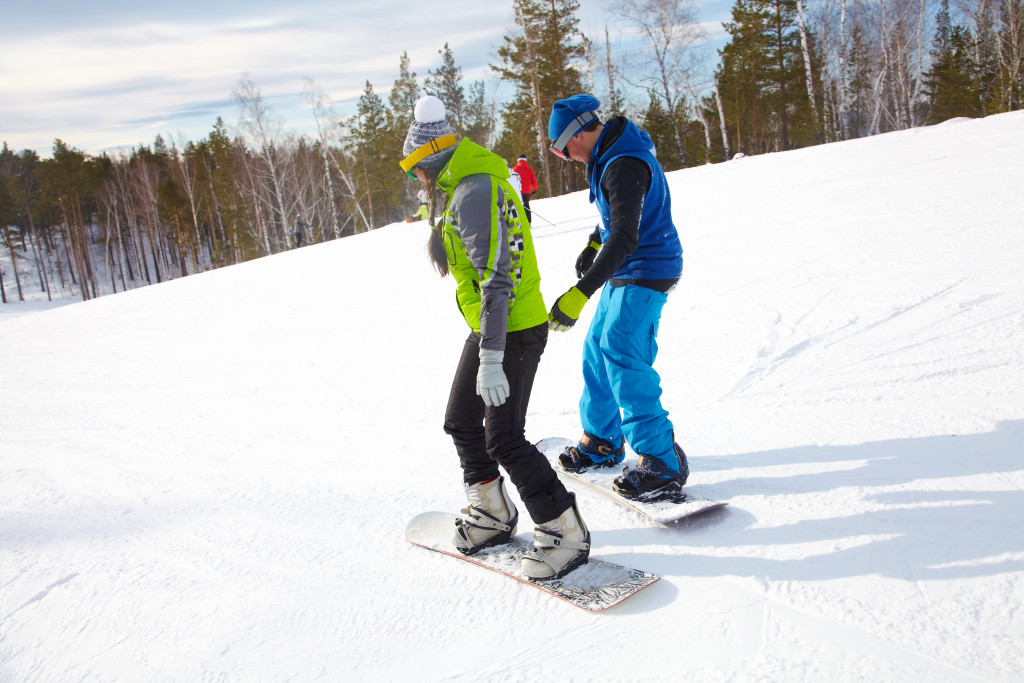The cold, harsh conditions that characterize winter sports make it necessary for a skier or snowboarder to bundle up. Some of the best ski clothes are specialized and pricey, but anyone who plans on skiing more than once can benefit from an investment in good gear. Having the right clothing will keep you safe and comfortable – even happy – when you’re enjoying the outdoors.
What to Wear on the Slopes
The basic dress for skiing or snowboarding consists of long underwear, a fleece jacket, snow pants, and boots covering your ankles, with gloves and a cap as accessories.
One Popular Option: Layering Long Underwear
So many choices are available in long underwear these days that it is difficult to know where to begin. Some garments are made of thin light material that keeps the warmth in and the cold out while providing a comfortable fit. Other options run toward bulkier sacks intended for arctic expeditions.
One option is to layer your underwear so that you don’t have a single piece that’s both too heavy and too light. Your first layer should be snug-fitting long underwear made of a high-quality, quick-drying material such as merino wool.
You can wear extra-thick long johns or the ultra-heavyweight version of your first pick. You’ll want to wear this layer when it gets really cold out, and you can take it off as soon as you reach the top. You can also choose a set of thermal underwear made with synthetic fibers or polypropylene to help your body retain heat.
Note, though, that you still have to wear pants over the long johns, and you want both to be comfortable. Women and women should find the right size of pants. You can shop for Bogner women’s ski pants as the pair is usually available in different sizes. It also provides great warmth and stretchability, so it doesn’t make the long johns feel too tight.
Light and Medium-Weight Layering Options
Wear long johns underneath your jeans, sweatshirts, and ski pants for additional warmth without bulkiness. If you find yourself feeling too warm, you can unzip the outer layer and let your perspiration-soaked long underwear “wick away” the heat in seconds.
The same principle applies to a snowboarder who wants to keep their legs warm without getting overheated while riding down the hill. A thin pair of long johns is intended for use underneath a pair of snowboard pants. In areas where the climate is frigid, you can use two layers of long underwear to keep your legs and torso warm without sacrificing mobility.
The advantage that lightweight layering provides is versatility. You can replace a single heavy layer with two lighter ones as the weather changes during your winter excursion. This way, you can save on space by bringing just one or two layers of clothing as opposed to half a dozen. Thick knits help keep your body warm without causing you to overheat, so they’re an excellent choice if you’re working hard while skiing or boarding down the mountain.
Lightweight items include a lighter pair of long or thermal underwear, a thinner fleece jacket, and lighter boots. You’ll want to add a neck gaiter or balaclava (a scarf worn around the face), gloves, and a cap for maximum comfort when you’re on the slope.

Additional Warmth Through Layering Options
The best layering options are made from materials that trap warm air and insulate your body. The key to staying comfortable on the slopes is to remain dry by wicking away sweat so that it doesn’t soak through your clothing. When your skin gets wet, you start losing heat from your body much more quickly than if you “bundle up” with layering options that are meant for use in cold temperatures.
When to Add Accessories
The accessories you choose add extra warmth without adding bulk, so you should wear them during periods of extreme cold. Neck gaiters and balaclavas both provide additional protection for your neck, face, and ears without inhibiting movement or sight. Gloves allow you to retain the feeling in your hands even after you’ve gone snowboarding or skiing for several hours.
The cap worn over your head and ears keeps the heat in through natural processes of conduction, as well as by trapping warm air in its many layers. You can also wear a larger hat under your helmet to add an extra layer without creating pressure points on your head or elsewhere on your body.
If you’re planning to go skiing or snowboarding with kids, make sure the novelty of winter clothing doesn’t outweigh its performance. Since children tend to move more quickly than adults, they generate much more heat and need less protection from extreme weather conditions. A pair of long johns under a pair of ski pants should provide the warmth a child needs.
Lightweight sweaters and jackets are also a good choice for anyone who plans to do some hiking on the slopes rather than just skiing or boarding down the mountain. The extra layer provides warmth without impeding motion, so you can hike up to the first peak quickly and get on with enjoying your day outdoors in winter weather!

